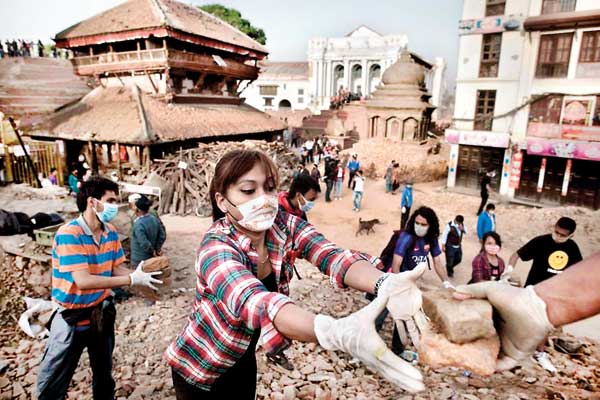
.jpg)
The recent earthquake in Nepal has served as a somber reminder of the kind of damage temblors can cause.
They follow a historic pattern, with a gap between events of 80 years or so. When a large earthquake occurs, however, it is also common for the tectonic movement to transfer strain further along the earthquake fault, and experts suggest we should probably expect another big earthquake to the west and south of this latest one in the coming decades.
On one hand it could happen tomorrow, on the other it may not happen for another 80 years. So the question is: do we need earthquake insurance for our homes? Or is that a gamble we are willing to take?
Any kind of insurance is really a gamble. We don’t buy insurance to just protect ourselves from likely occurrences. We buy insurance to guard against unlikely and financially devastating events. That’s why we buy life insurance: most of us don’t expect our families to need it. However, not having coverage could mean a financial nightmare for our families if the unlikely should happen and a breadwinner dies prematurely.
Of course, some people wouldn’t buy, say, third-party auto liability coverage at all if it wasn’t required by law. Some would even forgo homeowners insurance if their mortgage lenders didn’t force them to buy it. Some people are more than willing to roll the dice, but they should be clear about the real stakes.
Individual and societal component
The decision to purchase earthquake insurance has an individual component and a societal component. Since insurance is subject to contract law and not political will, from an individual household perspective privately secured capital is better because you get money faster to rebuild after a quake.
Chile, a nation much poorer than the US, has shown the way with almost immediate recovery after an 8.8 magnitude earthquake cut roughly 20 percent of its GDP in 2010. This is because 96 percent of homes with a mortgage were covered by private earthquake insurance since the banks had required it.
From a societal perspective, reliance on government aid creates an untenable situation where for every $1 spent on aid, individuals in high-risk areas forego spending $6 on private insurance even in a developed country like the US. With the passage of time and recurrence of this cycle, larger and larger amounts of government assistance are needed.
A common reason people avoid purchasing earthquake insurance is because they feel the government will come to the rescue with financial assistance after a major disaster. But they don’t realize that even if the government offers help to those affected, there is no guarantee it will cover everything. A California Earthquake Authority brochure warns: “Federal and state funds alone are unlikely to be enough to get your life back to its pre-disaster condition”.
Seismic designs
In the past decade, many Asian countries in seismically active regions have experienced tremendous urban expansion and rapid development. Most buildings are old, aren’t seismically reinforced, and aren’t expected to withstand the next major earthquake.
While many newer buildings have been built to higher seismic design standards, they are still expected to sustain damage in a large event. As a result, people are assessing whether or not to purchase earthquake insurance.
Self-imposed limits
Insurers have not vigorously marketed earthquake insurance nor made it a particularly attractive buy to most potential purchasers, owing to a basic concern related to their payout capacity and insolvency risk. They are unwilling to write earthquake policies—beyond certain self-imposed limits—due to adverse selection or the inability to spread the earthquake risk across an appropriately large number of exposed properties owing to low levels of insurance penetration.
Moreover, the lack of accurate and reliable data, and absence of catastrophe modeling, makes it difficult for them to understand, evaluate, and manage earthquake risk exposure, calculate probable losses and premium rates, and secure an adequate level of reinsurance.
Since earthquake risk is not abating, and since government largess is not a guarantee, some policymakers have taken the first step – overcoming a situation of market failure by establishing earthquake insurance pools.
For example, the main rationale behind the creation of the Turkish Catastrophe Insurance Pool was a grave government fiscal exposure to natural disasters and a disproportionately low level of catastrophe insurance penetration. The New Zealand Earthquake Commission was established as a special purpose entity to act as the primary provider of seismic cover for residential property owners. Both this and the earthquake insurance scheme in Japan, which seeks to stabilize the livelihoods of affected populations in the event of earthquakes, demonstrate that governments can play an important role in the delivery of viable earthquake insurance alongside the private sector.
Time-consuming
While putting an earthquake insurance pool in terms of preparing for a disaster takes time, sometimes a nudge is in the best interest of society’s economic health.
We can start by making lenders require insurance for earthquake risks as a condition to approving a mortgage. This will help improve the quality of earthquake policies, since the risk pool would be larger and the institutions financing the risk could bundle earthquake risk with other risks unlikely to be realized at the same time.
On the consumer end, lower deductibles, lower premiums and discounts for mitigation efforts could all be made available. As a spin-off, it will help raise earthquake awareness of the general population, and promote safe construction for new property through building codes.
Homeowners should be made to realize that when they let their banks foreclose on earthquake-devastated homes not only do they lose all their equity, but also put their credit rating at risk.
Depending on lenders’ reactions, it may be difficult or impossible to borrow money for another home for several years. For many of us, our homes represent our largest financial asset. We should think twice before considering walking away without earthquake insurance. (Courtesy ADB Blog)
(Arup Chatterjee is a principal financial sector specialist at ADB)

.jpg)